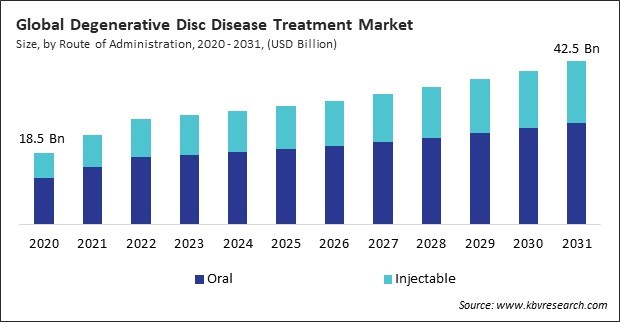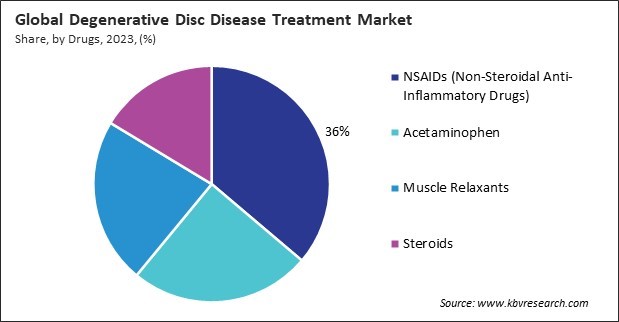“Global Degenerative Disc Disease Treatment Market to reach a market value of USD 42.5 Billion by 2031 growing at a CAGR of 5.3%”
The Global Degenerative Disc Disease Treatment Market size is expected to reach $442.5 Billion by 2031, rising at a market growth of 5.3% CAGR during the forecast period.
Many countries in the Asia-Pacific region have made significant investments in healthcare infrastructure, expanding access to specialized medical facilities, spine centers, and rehabilitation clinics equipped with advanced diagnostic technologies and treatment modalities for managing DDD. Consequently, the Asia Pacific region would acquire nearly 25% of the total market share by 2031.

Increased awareness leads to earlier recognition of symptoms and encourages individuals to seek medical advice sooner. In addition, greater awareness often spurs investments in diagnostic technologies, such as MRI scans, CT scans, and other imaging modalities. Thus, the rising awareness and early diagnosis of spinal disorders drive the market's growth. Additionally, Higher healthcare spending allows healthcare systems to invest in advanced treatment options for degenerative disc disease. Increased funding enables the expansion and modernization of healthcare facilities, including specialized centers for spinal health.
However, the high cost of advanced treatments such as minimally invasive surgeries, biologic therapies, and regenerative medicine can be prohibitive for many patients. Many insurance providers may not cover the full cost of advanced DDD treatments or may have stringent criteria for coverage approval. Hence, high treatment costs are impeding the growth of the market.
Moreover, Restrictions on international and domestic logistics disrupted the supply chain for medical devices and pharmaceuticals used in DDD treatments. This led to shortages and delayed availability of necessary treatment options. Economic uncertainties caused by the pandemic led to financial constraints for healthcare providers and patients. Thus, the COVID-19 pandemic had a negative impact on the market.
By route of administration, the market is segmented into injectable and oral. The injectable segment procured a 35% revenue share in the degenerative disc disease treatment market in 2023. Injectables allow for direct delivery of medications to specific sites within the spine affected by DDD.
Based on drugs, the degenerative is divided into acetaminophen, NSAIDs (non-steroidal anti-inflammatory drugs), muscle relaxants, and steroids. The muscle relaxants segment attained a 22% revenue share in the degenerative disc disease treatment market in 2023. Muscle relaxants are effective in relieving muscle spasms, which are common symptoms of DDD.

Based on end use, the market is categorized into hospitals, clinics, and others. The clinics segment witnessed 34% growth rate in the degenerative disc disease treatment market in 2023. Clinics provide accessible healthcare services in community settings, making it easier for patients with DDD to seek timely medical attention and treatment close to their homes.
On the basis of treatment type, the market is segmented into occupational therapy, physical therapy, special exercises, medications, and weight loss surgery. In 2023, the occupational therapy segment attained 22% revenue share in the degenerative disc disease treatment market. Occupational therapy focuses on enhancing a person's ability to perform activities of daily living (ADLs) independently and safely.
Free Valuable Insights: Global Degenerative Disc Disease Treatment Market size to reach USD 42.5 Billion by 2031
Region-wise, the market is analyzed across North America, Europe, Asia Pacific, and LAMEA. The North America region witnessed 40% revenue share in the market in 2023. In North America, sedentary lifestyles are common, marked by extended periods of sitting, inadequate physical activity, and poor posture.
| Report Attribute | Details |
|---|---|
| Market size value in 2023 | USD 28.4 Billion |
| Market size forecast in 2031 | USD 42.5 Billion |
| Base Year | 2023 |
| Historical Period | 2020 to 2022 |
| Forecast Period | 2024 to 2031 |
| Revenue Growth Rate | CAGR of 5.3% from 2024 to 2031 |
| Number of Pages | 300 |
| Tables | 460 |
| Report coverage | Market Trends, Revenue Estimation and Forecast, Segmentation Analysis, Regional and Country Breakdown, Porter’s 5 Forces Analysis, Company Profiling, Companies Strategic Developments, SWOT Analysis, Winning Imperatives |
| Segments covered | Treatment Type, Drugs, Route of Administration, End-use, Region |
| Country scope |
|
| Companies Included | Medtronic PLC, AstraZeneca PLC, Pfizer, Inc., Novartis AG, Eli Lilly And Company, Spine Wave Inc., B. Braun Melsungen AG (Aesculap, Inc.), DiscGenics, Inc., Spine BioPharma Inc. and Stryker Corporation |
By Route of Administration
By Drugs
By End Use
By Treatment Type
By Geography
This Market size is expected to reach $442.5 Billion by 2031.
Rising awareness and early diagnosis of spinal disorders are driving the Market in coming years, however, Rising awareness and early diagnosis of spinal disorders restraints the growth of the Market.
Medtronic PLC, AstraZeneca PLC, Pfizer, Inc., Novartis AG, Eli Lilly And Company, Spine Wave Inc., B. Braun Melsungen AG (Aesculap, Inc.), DiscGenics, Inc., Spine BioPharma Inc. and Stryker Corporation
The expected CAGR of this Market is 5.3% from 2024 to 2031.
The Oral segment generated the highest revenue in the Market by Route of Administration in 2023; thereby, achieving a market value of $26.4 billion by 2031.
The North America region dominated the Market by Region in 2023, and would continue to be a dominant market till 2031; thereby, achieving a market value of $16 billion by 2031.
Our team of dedicated experts can provide you with attractive expansion opportunities for your business.

 Drivers
Drivers
 Restraints
Restraints
 Opportunities
Opportunities
 Challenges
Challenges
